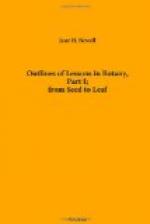Sometimes the water is drawn up into the cells of the leaves faster than it can escape into the atmosphere.[1] This is prettily shown if we place some of our Nasturtium seedlings under a ward-case. The air in the case is saturated with moisture, so that evaporation cannot take place, but the water is, nevertheless, drawn up from the roots and through the branches, and appears as little drops on the margins of the leaves. That this is owing to the absorbing power of the roots, may be shown by breaking off the seedling, and putting the slip in water. No drops now appear on the leaves, but as soon as the cutting has formed new roots, the drops again appear.
[Footnote 1: See Lectures on the Physiology of Plants. By Sidney Howard Vines, Cambridge, England. University Press, 1886. Page 92.]
This constant escape of water from the leaves causes a current to flow from the roots through the stem into the cells of the leaves. The dilute mineral solutions absorbed by the roots[1] are thus brought where they are in contact with the external air, concentrated by the evaporation of water, and converted in these cells into food materials, such as starch. The presence of certain mineral matters, as potassium, iron, etc., are necessary to this assimilating process, but the reason of their necessity is imperfectly understood, as they do not enter in the products formed.
[Footnote 1: See page 48.]
The amount of water exhaled is often very great. Certain plants are used for this reason for the drainage of wet and marshy places. The most important of these is the Eucalyptus tree.[1]
[Footnote 1: Reader in Botany. XII. Transpiration.]
“The amount of water taken from the soil by the trees of a forest and passed into the air by transpiration is not so large as that accumulated in the soil by the diminished evaporation under the branches. Hence, there is an accumulation of water in the shade of forests which is released slowly by drainage.[1] But if the trees are so scattered as not materially to reduce evaporation from the ground, the effect of transpiration in diminishing the moisture of the soil is readily shown. It is noted, especially in case of large plants having a great extent of exhaling surface, such, for instance, as the common sunflower. Among the plants which have been successfully employed in the drainage of marshy soil by transpiration probably the species of Eucalyptus (notably E. globulus) are most efficient."[2]
[Footnote 1: Reader in Botany. XIII. Uses of the Forests.]
[Footnote 2: Physiological Botany, page 283.]
4. Assimilation.—It is not easy to find practical experiments on assimilation. Those which follow are taken from “Physiological Botany” (p. 305).




